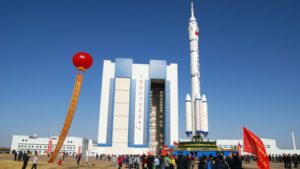
The National Interest:
For many watchers of the Asia-Pacific, anti-access/area-denial (A2/AD) is the most serious challenge the U.S. faces in shaping its forces for the region. Anti-access/area-denial (A2/AD) is a Chinese strategy based around restricting enemy access to a certain strategic location, while it exerts forceful control over a territorial asset like Taiwan or a disputed maritime claim. It is designed to “deter, dissuade or defeat” the involvement of a third party in a confrontation or conflict over such issues, and is targeted at the United States or any of its Pacific allies that might intervene.
At the same time, the actual implementation of A2/AD is immensely complicated. Both China and the United States need to be careful in assessing what China can and cannot do, and what its strategic impact is in both the competition and risk of conflict between them.
A2/AD requires advanced intelligence, surveillance, and reconnaissance (ISR), as well as advanced targeting, communications, naval, air, missile defense, and cyber capabilities. China has spent a “generation” attempting to develop the technological capabilities necessary, and it still remains debatable if they are capable of A2/AD implementation. If China is to successfully develop A2/AD capability, it will owe much credit to its rapidly advancing space capability and satellite infrastructure.
At its simplest, A2/AD is centered on conventional counterforce targeting. In order to deny access, China must be able to execute a kill-chain starting with, “target detection and including munition delivery, weapon guidance, damage assessment, and potential restrike” of its opponent’s battleships, aircraft carriers, fighter jets, submarines, information hubs, and missile positions at long distances.
This requires significant tracking and C4ISR ability, much of which can only be provided by space-based assets. Further necessitating advanced space-based tracking capabilities is the fact that the Pacific Ocean is a massive battlefield. China has roughly 875,000 nautical square miles in its near seas area to monitor and control—expanding to another 1.5 million if the strategically important Philippine Sea becomes involved. Additionally, the seas lanes near China’s coast are some of worlds most trafficked by civilian ships making tracking and identification even more difficult.
China must also build the integrated system necessary for the substantial tracking needed for A2/AD. This requires, “high-quality real-time satellite imagery and target locating data and fusion, as well as of reliable indigenous satellite positioning, navigation, and timing (PNT)”. Accordingly, China has undergone a substantial expansion of its satellite program. In 2000, China possessed only 10 satellites, that number now stands at 181. For comparison, the United States and Russia have 576 and 140, respectively. China shows no signs of slowing down, having launched a Gaofen 3 satellite on August 10th, with a Chinese official noting, “Gaofen 3 will be very useful in safeguarding the country’s maritime rights and interests”.
China has also now deployed satellites with an array of capabilities such as electro-optical (EO), synthetic aperture radar (SAR), and electronic reconnaissance (ELINT). Different satellites have various weaknesses like tracking during poor weather conditions, functioning at nighttime, and image quality. Thus, it is of paramount importance to maintain an array of satellite technology for tracking moving targets.
Next, China’s A2/AD strategy requires space capabilities for missile guidance. To this end China has spent years developing its own version of Global Positioning System (GPS) entitled Beidou. Currently, Beidou has 19 operational satellites and is deployed regionally by the PLA with plans to expand to worldwide coverage by 2020 following expansion to 35 total satellites.
Most missiles utilize some sort of GPS or similar technology for targeting. This is a lesson that China learned in a particularly shocking way during the 1995-1996 Taiwan Strait Crisis. In the midst of the crisis, China was “testing” missiles by launching them in the vicinity of Taiwan. However, in the midst of these tests the PLA was unable to track a number of the launched missiles.
